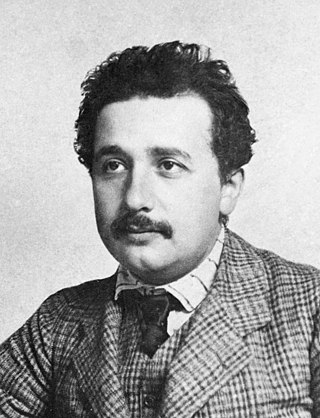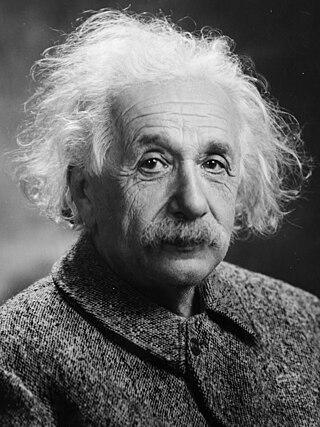Related Research Articles

Differential geometry is a mathematical discipline that studies the geometry of smooth shapes and smooth spaces, otherwise known as smooth manifolds. It uses the techniques of differential calculus, integral calculus, linear algebra and multilinear algebra. The field has its origins in the study of spherical geometry as far back as antiquity. It also relates to astronomy, the geodesy of the Earth, and later the study of hyperbolic geometry by Lobachevsky. The simplest examples of smooth spaces are the plane and space curves and surfaces in the three-dimensional Euclidean space, and the study of these shapes formed the basis for development of modern differential geometry during the 18th and 19th centuries.

General relativity, also known as the general theory of relativity, and as Einstein's theory of gravity, is the geometric theory of gravitation published by Albert Einstein in 1915 and is the current description of gravitation in modern physics. General relativity generalizes special relativity and refines Newton's law of universal gravitation, providing a unified description of gravity as a geometric property of space and time, or four-dimensional spacetime. In particular, the curvature of spacetime is directly related to the energy and momentum of whatever present matter and radiation. The relation is specified by the Einstein field equations, a system of second-order partial differential equations.

In physics, the special theory of relativity, or special relativity for short, is a scientific theory of the relationship between space and time. In Albert Einstein's 1905 paper, On the Electrodynamics of Moving Bodies, the theory is presented as being based on just two postulates:
- The laws of physics are invariant (identical) in all inertial frames of reference. This is known as the principle of relativity.
- The speed of light in vacuum is the same for all observers, regardless of the motion of light source or observer. This is known as the principle of light constancy, or the principle of light speed invariance.

The theory of relativity usually encompasses two interrelated physics theories by Albert Einstein: special relativity and general relativity, proposed and published in 1905 and 1915, respectively. Special relativity applies to all physical phenomena in the absence of gravity. General relativity explains the law of gravitation and its relation to the forces of nature. It applies to the cosmological and astrophysical realm, including astronomy.

Mathematical physics refers to the development of mathematical methods for application to problems in physics. The Journal of Mathematical Physics defines the field as "the application of mathematics to problems in physics and the development of mathematical methods suitable for such applications and for the formulation of physical theories". An alternative definition would also include those mathematics that are inspired by physics, known as physical mathematics.
Since the 19th century, some physicists, notably Albert Einstein, have attempted to develop a single theoretical framework that can account for all the fundamental forces of nature – a unified field theory. Classical unified field theories are attempts to create a unified field theory based on classical physics. In particular, unification of gravitation and electromagnetism was actively pursued by several physicists and mathematicians in the years between the two World Wars. This work spurred the purely mathematical development of differential geometry.

Marcel Grossmann was a Swiss mathematician who was a friend and classmate of Albert Einstein. Grossmann came from an old Swiss family in Zürich. His father managed a textile factory. He became a Professor of Mathematics at the Federal Polytechnic School in Zürich, today the ETH Zurich, specializing in descriptive geometry.
A classical field theory is a physical theory that predicts how one or more fields in physics interact with matter through field equations, without considering effects of quantization; theories that incorporate quantum mechanics are called quantum field theories. In most contexts, 'classical field theory' is specifically intended to describe electromagnetism and gravitation, two of the fundamental forces of nature.
In theoretical physics and applied mathematics, a field equation is a partial differential equation which determines the dynamics of a physical field, specifically the time evolution and spatial distribution of the field. The solutions to the equation are mathematical functions which correspond directly to the field, as functions of time and space. Since the field equation is a partial differential equation, there are families of solutions which represent a variety of physical possibilities. Usually, there is not just a single equation, but a set of coupled equations which must be solved simultaneously. Field equations are not ordinary differential equations since a field depends on space and time, which requires at least two variables.
The history of special relativity consists of many theoretical results and empirical findings obtained by Albert A. Michelson, Hendrik Lorentz, Henri Poincaré and others. It culminated in the theory of special relativity proposed by Albert Einstein and subsequent work of Max Planck, Hermann Minkowski and others.

Carl Henry Brans is an American mathematical physicist best known for his research into the theoretical underpinnings of gravitation elucidated in his most widely publicized work, the Brans–Dicke theory.

Relativistic electromagnetism is a physical phenomenon explained in electromagnetic field theory due to Coulomb's law and Lorentz transformations.
For classical dynamics at relativistic speeds, see relativistic mechanics.
In theoretical physics, Whitehead's theory of gravitation was introduced by the mathematician and philosopher Alfred North Whitehead in 1922. While never broadly accepted, at one time it was a scientifically plausible alternative to general relativity. However, after further experimental and theoretical consideration, the theory is now generally regarded as obsolete.

Jürgen Ehlers was a German physicist who contributed to the understanding of Albert Einstein's theory of general relativity. From graduate and postgraduate work in Pascual Jordan's relativity research group at Hamburg University, he held various posts as a lecturer and, later, as a professor before joining the Max Planck Institute for Astrophysics in Munich as a director. In 1995, he became the founding director of the newly created Max Planck Institute for Gravitational Physics in Potsdam, Germany.
Tevian Dray is an American mathematician who has worked in general relativity, mathematical physics, geometry, and both science and mathematics education. He was elected a Fellow of the American Physical Society in 2010.

Albert Einstein's discovery of the gravitational field equations of general relativity and David Hilbert's almost simultaneous derivation of the theory using an elegant variational principle, during a period when the two corresponded frequently, has led to numerous historical analyses of their interaction. The analyses came to be called a priority dispute.
Tilman Sauer is a German theoretical physicist and historian of the natural sciences. He has an international reputation as an expert on the history of the development of general relativity theory.

Although Albert Einstein's general theory of relativity, contains some of the most powerful arguments and concepts ever presented in the history of gravitational theory, some aspects of Einstein's attempted implementation of a general theory have been found to be problematic, with some of the major criticisms coming from Einstein himself.
References
- ↑ "Dalai Lama hosts interactive discussion on Indian Philosophy and Modern Sciences". Phayul. 4 November 2016. Archived from the original on 5 March 2017. Retrieved 4 November 2016.
- 1 2 Pisharoty, Sangeeta Barooah (18 September 2003). "Beyond the history of Time". The Hindu . Archived from the original on 20 August 2004. Retrieved 24 April 2009..
- ↑ "Gold Medal Winners 2010".
- ↑ Raju, C. K. "product of Schwartz distributions".
- ↑ Raju, C. K. "Interpretation of quantum mechanics as a theory of extended particles".
- ↑ Raju, C. K. "Einstein's Time".
- ↑ Mathematics and Culture. Implications of philosophy and culture for contemporary mathematics. Book Review. The Hindu. 12 February 2008
- ↑ José Ferreirós (2009), "Book Review: C.K. RAJU. Cultural Foundations of Mathematics: The Nature of Mathematical Proof and the Transmission of the Calculus from India to Europe in the 16th c. CE.", Philosophia Mathematica, 17, archived from the original on 15 April 2013
- ↑ D.P. Agrawal, The Kerala School, European Mathematics and Navigation
- ↑ C. K. Raju, Time: Towards a Consistent Theory, Kluwer Academic, 1994, Chapter 5b. The error is that the essential history-dependence of the relativistic many-body problem has been washed away by using a Taylor expansion in powers of the delay to convert a retarded functional differential equation into an ordinary differential equation.
- ↑ C.K. Raju. Electromagnetic Time, chapter 5b, p.116-35 in Raju, C.K. (1994). Time: Towards a Consistent Theory. Kluwer Academic. ISBN 978-0-7923-3103-2.
- ↑ See Raju, C.K. (2003). The Eleven Pictures of Time. Sage. ISBN 978-0-7619-9624-8. p.298-299.
- ↑ Raju, C. K. (October 2012). "Retarded gravitation theory". AIP Conference Proceedings. 1483 (1): 260–276.
- ↑ Giné, Jaume (November 2008). "On the origin of the anomalous precession of Mercury's perihelion". Chaos, Solitons & Fractals. 38 (4): 1004–1010.
- ↑ Giné, Jaume (January 2008). "On the origin of the deflection of light". Chaos, Solitons & Fractals. 35 (1): 1–6.
- ↑ Hafele, Joseph C. (April 2013). "Causal Version of Newtonian Theory by Time-Retardation of the Gravitational Field Explains the Flyby Anomalies" (PDF). Progress in Physics. 2 (2): 3. Bibcode:2013PrPh....9b...3H. ISSN 1555-5534.
- ↑ "GroundUp: UCT invites 'conspiracy theorist' to talk about decolonisation of science". Daily Maverick. Archived from the original on 29 September 2017.
- ↑ Review of The Eleven Pictures of Time in Time and Society, London, 13(2), September, 2004, pp. 405-7
- ↑ "Cultural Foundations of Mathematics" (PDF), Ghadar Jari Hai, vol. 2, no. 1, 2007, archived from the original (PDF) on 11 October 2010, retrieved 13 April 2009 Book Review
- ↑ Raju, C.K. "Towards Equity in Mathematics Education 1. Goodbye Euclid!", Bharatiya Samajik Chintan, Indian Academy of Social Science. pp. 255-264. 2009.
- ↑ Education, Positions held and Society memberships, Institutions, ckraju.net